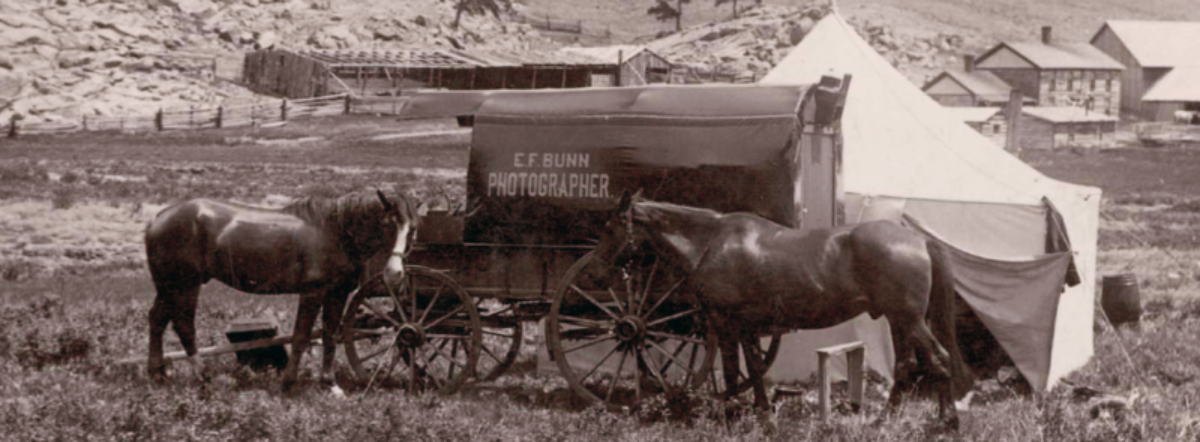Allen Grant Wallihan and his wife, Mary Augusta Wallihan lived in sparsely populated northwestern Colorado where they were skilled with both the gun and the camera. Mary picked up a camera first, but soon both Wallihans shared this passion. Most publications credit Allen as the photographer and overlook Mary’s involvement, a common occurrence in photographic history, as women photographers were often considered assistants or helpers, rather than working behind the camera.

Mary Augusta Higgins was born on February 22, 1837, at Oak Creek, Wisconsin to Elihu Higgins and Eliza (Rawson) Higgins. Mary’s father was one of the first settlers at South Milwaukee and Mary was purportedly the first “white child” born at Oak Creek. She married Cullen Farnham on June 1, 1865, at Croton Falls, New York. The 1870 census lists Cullen and Mary living in Waukesha, WI, with Mary’s parents. In the 1870s, she and her husband were living in Salt Lake City, Utah. Mary filed for divorce in 1877, claiming that Farnham had abandoned her without financial support. They divorced in 1880 and shortly thereafter she moved to her brother’s ranch in Routt County, CO.

Mary married Allen G. Wallihan, twenty-two years her junior, on April 16, 1885, at Rawlins, WY. The couple lived in remote northwestern Colorado, twenty miles from their nearest neighbor. Mrs. Wallihan learned to shoot a rifle, first to protect herself when her husband was away, but she also became a proficient hunter. She developed a love for wildlife the led her to acquire a camera from a missionary that she used to photograph the local deer. She learned the craft of photography from books and manufacturer’s catalogs.
In 1888, she initiated a project, with her husband, to document Colorado’s widlife, becoming perhaps the earliest wildlife photographers. They used a crude large-format camera on a tripod, taking 4-1/4 x 6-1/2” glass plates. As they learned more about photography, they upgraded their equipment, purchasing better cameras and lenses, using both 5 x 8” and 8 x 10” cameras. They printed cyanotype proofs before selecting which negatives to make into finished prints that would be mounted on cards.

The Wallihans produced two compilations of wildlife photographs, Hoofs, Claws and Antlers of the Rocky Mountains (1894), with an introduction by Theodore Roosevelt, was published by Frank S. Thayer in Denver. Camera Shots at Big Game (1901) was published by Doubleday, Page & Co. and also included an introduction by Theodore Roosevelt. The Wallihan’s photographs were exhibited at the 1900 Paris Exposition and in 1904 at the Louisiana Purchase Exposition.
Mrs. Wallihan died on September 27, 1922, after suffering a stroke. She was 85 years old. She is buried near her home in Lay, Colorado.
Allen G. Wallihan was born at Footville, Wisconsin, on June 15, 1859 to Pierce and Lucy (Flower) Wallihan. He had ten older siblings. Wallihan arrived in Leadville, Colorado, in 1879, and worked unsuccessfully as a miner. He lived in Colorado Springs and Alpine, before moving to a horse ranch in Routt County in 1882. He homesteaded on 160 acres in Lay, a small town twenty-two miles west of Craig, where he lived for the remainder of his life.
Wallihan served as the postmaster of Lay for about fifty years. He spent the latter part of his career as a U. S. Land Commissioner, surveying, platting, and overseeing the sale of the public lands in the county. He also owned an interest in a large tract of bituminous coal. After Mary Wallihan’s death in 1922, Allen married Essaye Cook on September 26, 1927. Allen G. Wallihan died on December 14, 1935, after a stroke. He is buried in Lay, CO in a casket he himself made.
Bibliography: https://www.historycolorado.org/sites/default/files/media/document/2018/ColoradoMagazine_v21n5_September1944.pdf
Thank you to Beverly Brannan, former curator of photography at the Library of Congress, for proofreading.




